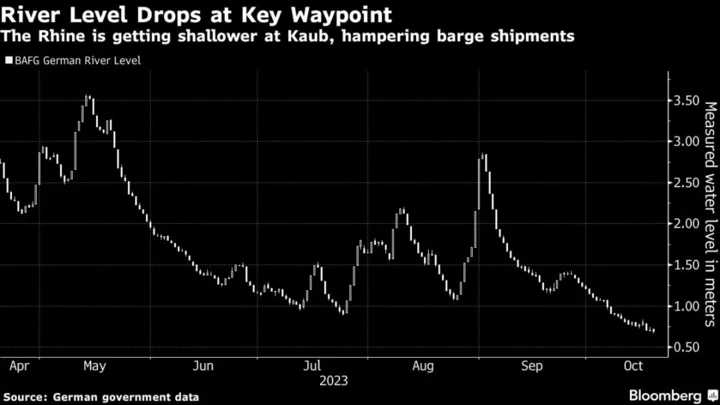The cost of shipping fuel along the Rhine river has surged as low water levels curb barges’ carrying capacity following a hot, dry September.
The river is fed by glaciers and rain. But Alpine ice flows are declining each year as glaciers shrink due to global warming, according to the International Commission for the Hydrology of the Rhine Basin. September was unusually dry in Germany, while temperatures were the highest for the month since records began, according to the country’s DWD federal weather service.
“The extraordinary temperatures in this record September in Germany are further evidence that we are in the midst of climate change,” said Tobias Fuchs, head of the climate and environment division at the DWD.
The price for shipping fuel on the river by barge has soared, with costs between Karlsruhe — upriver of Kaub — and the Netherlands touching €57 a ton on Thursday — the highest since late December. That comes as the measured water level at the river’s Kaub chokepoint near Frankfurt fell to 67 centimeters (26 inches), the shallowest for the time of year since 2018. If the water gets too low, then it becomes uneconomical for many barges to transit this point.
See also: Europe’s Most Important Trade Route Is at Risk as Waters Drop
The maximum load of diesel-type fuel for a standard 110-meter Rhine barge planning to pass through Kaub was limited recently to about 600 tons, said Mitchell van der Hoeven, a broker at Riverlake, which organizes shipments up the river.
The river at Kaub is usually at its shallowest in late fall, historical data show. Still, it’s forecast to deepen again in the coming days, with the measured water level projected to nudge above 90 centimeters on Saturday. Later this week, loads of about 1,000 tons and more will be possible for barges planning to pass through Kaub, van der Hoeven said.
With its source high in the Swiss Alps, the Rhine snakes about 800 miles through the industrial zones of Switzerland, Germany and the Netherlands before emptying into the North Sea. It serves as a key conduit for manufacturers such as BASF SE and Thyssenkrupp AG’s steel unit, as well as oil refiners.
--With assistance from Rachel Graham.
(Updates with September weather in 2nd paragraph, Riverlake comments starting in 5th; also updates Karlsruhe rate.)

